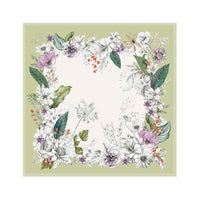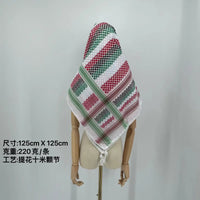Introduction: The unique charm of bamboo fiber scarves
Imagine that on a cold morning, you take out a light and soft scarf from your closet. It feels as smooth as silk, but has the moisture absorption of cotton, and can naturally inhibit the growth of bacteria - this is the everyday charm of bamboo fiber scarves. In recent years, this textile made of bamboo has quietly become popular, but what kind of technology and natural wisdom is hidden behind it?
The source of bamboo fiber: the secret of natural bamboo
Fast-growing "green gold"
Bamboo is one of the fastest growing plants on earth, and some varieties can grow 30 cm a day (data source: FAO United Nations Food and Agriculture Organization). Compared with cotton, bamboo cultivation does not require a lot of pesticides, and the yield per acre is 3-5 times higher, making it an ideal raw material for sustainable textiles.
Two paths from bamboo poles to fibers
1. Mechanical method (traditional process)
The bamboo fiber is peeled off by physical rolling and fermentation, similar to the retting process of flax. The resulting fiber is relatively coarse and is often used to make coarse cloth or handicrafts, but it retains the natural antibacterial component of bamboo - "bamboo quinone".

2. Chemical method (mainstream industrial production)
Dissolve bamboo chips in sodium hydroxide solution to make bamboo pulp, which is then spun through a spinneret, similar to the viscose fiber process (Wikipedia calls this "regenerated cellulose fiber"). This method can produce finer fibers, but chemical waste liquids must be strictly treated.
Tips: Most of the products labeled "bamboo raw fibers" on the market are mechanical products, while "bamboo pulp fibers" are usually produced by chemical methods.
Scientific analysis of bamboo fiber fabrics
Natural functional fabrics
- Breathability: The cross section is full of micropores, and the moisture absorption rate is 3.5 times that of cotton (Textile Materials Science, China Textile Press)
- Temperature regulation: The warmth retention in winter is 1-2℃ higher than cotton, and the perceived temperature in summer is about 1℃ lower
- Antibacterial property: The inhibition rate of Staphylococcus aureus can reach 70% (data from the Japan Textile Inspection Association)
Comparison with other fibers
| Characteristics | Bamboo fiber | Cotton | Wool |
| Hygroscopicity | ★★★★★ | ★★★★ | ★★★ |
| Antibacterial property | ★★★★ | ★★ | ★★★ |
| Anti-ultraviolet | UPF50+ | UPF15 | UPF20 |
Production process of bamboo fiber scarves
1. Spinning: from pulp to yarn
After dissolving and filtering, bamboo pulp is formed into continuous filaments through wet spinning. To increase strength, it is often blended with 5%-10% spandex - this is why your bamboo fiber scarf has both drape and is not easy to deform.
2. Weaving: the art of plain and jacquard
- Plain weave: suitable for thin spring and summer styles, with a weight of about 80-100g per square gram
- Double-layer jacquard: thick winter style, three-dimensional patterns are woven by electronic jacquard machines
3. Dyeing: plant dyeing and low-salt active dyeing
Environmentally friendly brands will use:
- Natural dyes: such as gardenia yellow and hematoxylin, but the color fastness is poor
- Low-temperature dyeing process: 40% energy saving compared to traditional processes, reducing fiber damage
4. Finishing: The secret of softness
The surface hairiness is removed through bio-enzyme polishing, and then treated with silicone softener. High-end products will use "nano self-assembly technology" to give waterproof function.
Daily Use and Maintenance Guide
Scenario Experience:
- Commuting on the subway: Bamboo fiber's moisture absorption can reduce the stuffiness of the neck
- Outdoor sports: UPF50+ sun protection performance is comparable to professional sun protection clothing
Maintenance Tips:
1. Put it in a laundry bag when washing by machine, and select "gentle mode"
2. Avoid drying, lay it flat to dry to prevent deformation
3. Wash it separately from dark clothes (there may be slight fading in the early stage)
Environmental Controversy and the Future
Ignored Chemical Footprint
Although bamboo is environmentally friendly to grow, the chemical production process:
- 0.5 tons of sodium hydroxide is consumed per ton of fiber
- Wastewater contains sulfides and needs professional treatment (Greenpeace report)
Conclusion: A green choice for a scarf
When you hold a hot cocoa in a cafe, the bamboo fiber scarf will not retain food odor like wool; when you are in a hurry, it is not easy to generate static electricity and entangle your hair. More importantly, this scarf comes from a bamboo forest that can be regenerated in 3 years, rather than a tree that takes 20 years to grow. Perhaps, this is the most tangible appearance of sustainable fashion.
References:
1. "Chemistry and Physics of Natural Fibers", China Textile Press
2. Wikipedia "Bamboo textile" entry
3. International Bamboo and Rattan Organization (INBAR) technical report
4. Textile Research Journal multiple papers on bamboo fiber performance










